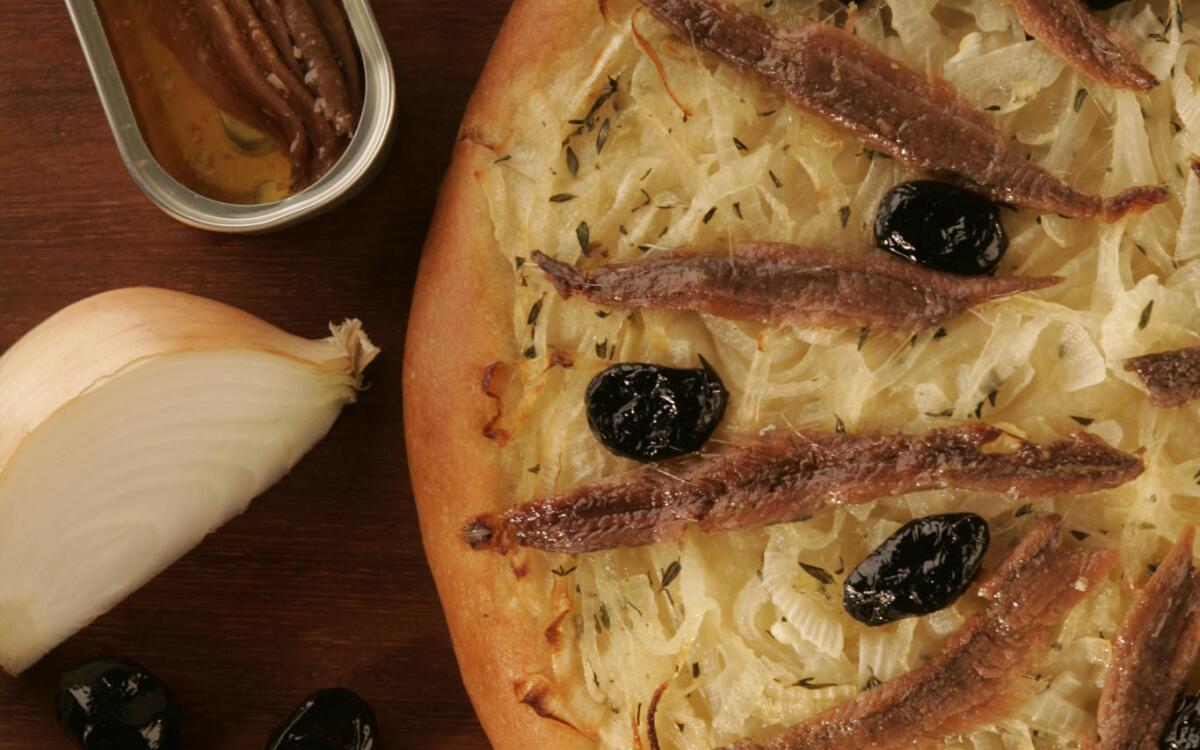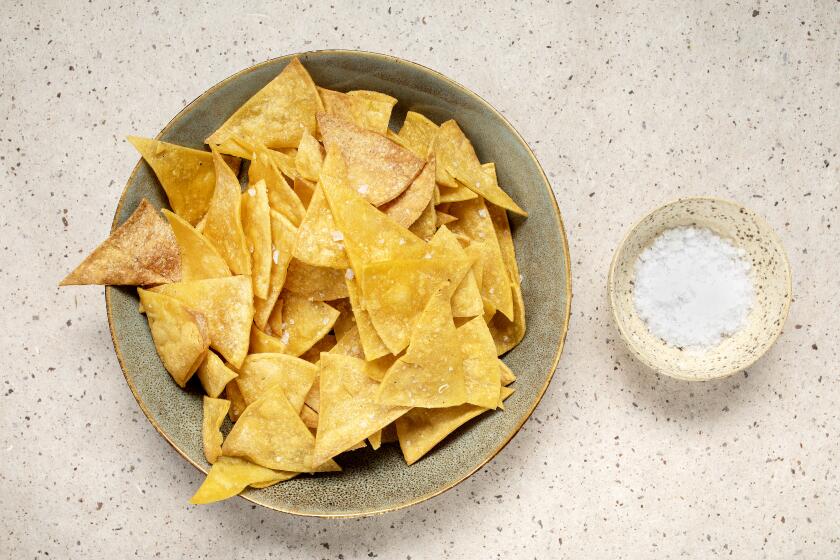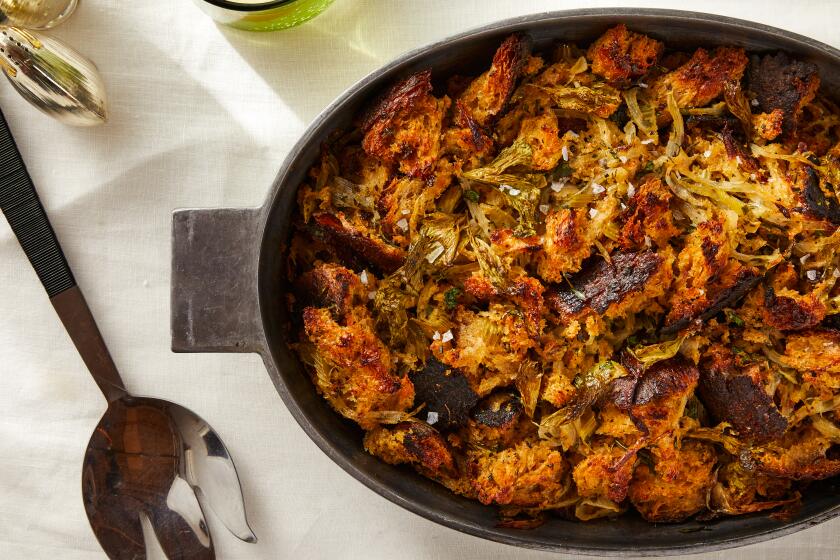Pissaladiere

At an Italian restaurant in New York the other night, the inevitable little dish of olive oil with bread arrived with something different: radishes in a second little dish of oil with fat bits of anchovies strewn over them.
The combination was completely unexpected but tasted absolutely right: salty-rich against cold and crisp, with just enough of a hint of the sea to take the whole idea a notch beyond the French spread of butter and salt.
Ordinarily I prefer my anchovies undercover -- melded into a green goddess or Caesar dressing rather than splayed out over lettuce leaves -- but the crudite treatment gave me a renewed appreciation of the most useful canned food since the tomato. I had forgotten just how suited they are to summer, and the reason they turn up in every hot kitchen from Provence down to Sicily: You get flavor fast.
Anchovies are never anything you want to eat by the forkful, but if you combine them with the right partners, and treat them almost as a seasoning, they contribute a deeper, more intense, virtually rounded taste to any dish.
Used right, there’s nothing fishy about them.
The radish presentation was obviously a variation on bagna cauda, the Italian “warm bath” of anchovies in hot oil served as a dip for raw vegetables, which is the most classic and basic example of how to multiply flavor with tiny fillets. The same combination works equal sorcery with any other raw vegetables, whether cherry tomatoes or zucchini, and even steamed corn on the cob. And when you add vinegar to the mixture, you get a classic dressing for salad or asparagus.
When anchovies are added to a cooked dish, the flavor mystique only intensifies. I always use a few (or a fat squeeze of anchovy paste) in tomato sauce for pasta to give it that meaty aspect when there’s no time to simmer something for an hour. And, of course, I’m following in the noble steps of the Italian prostitutes who devised puttanesca sauce when they needed to get food to their families in a hurry after spending the afternoon otherwise engaged. Their innovation, with capers and olives, is an idea too good to limit to linguine: The same sauce makes an excellent topping for bruschetta, like salsa with resonance.
I’ve been using anchovies with grilled or steamed eggplant ever since trying a recipe from a cookbook by Jacques Maximin of Nice. It was a disaster as the pate he billed it as, but fabulous as a puree. Like anchovies, eggplant can taste almost meaty; add good olive oil and lots of fresh basil when you put the two in the blender and the combination will be much more than the parts as a side dish. Or even a sauce.
Best fast sauce
A grilling friend who apparently knows exactly one recipe also taught me the best fast sauce for swordfish or tuna: Mash a few anchovies into butter and let it melt over the steaks. The same simple idea can transform roasted or grilled vegetables, particularly a combination of sliced zucchini and shiitake mushrooms, if you substitute great olive oil for the butter and toss in a little herbes de Provence. You won’t taste anchovies overtly, only an indefinable richness.
Even fully exposed anchovies can blend into the background. On pissaladiere -- the Provencal flatbread-tart covered with them -- the pungent oil-cured olives balance their aggressiveness while the anchovies just about melt into the sweet braised onions. And in a potato salad, you can use an entire tinful if you start with very flavorful piquillo peppers and hard-cooked eggs, which go with anchovies the way bacon does with tomatoes (and eggs).
Anchovies are so versatile I always have at least as many cans in my kitchen cabinet as tomatoes and black beans. Quick flavor should always be at arm’s reach -- especially in summer.
For the dough, place three-fourths cup warm water into a mixing bowl, sprinkle the yeast over and stir until dissolved. Using a wooden spoon, stir in the sugar, the kosher salt, one-fourth cup oil and the flour; mix until very smooth. Lift the dough from the bowl and knead lightly on a lightly floured board about 15 times.
Place the dough in an oiled mixing bowl, turning to coat the dough with oil on all sides. Cover with a damp dish towel and place in a warm spot. Let stand until the dough is doubled in bulk, 1 to 1 1/2 hours.
While the dough rises, heat the remaining 2 tablespoons oil in a deep saute pan over medium-low heat. Add the onions and sprinkle with the sea salt. Cook, stirring often, until very soft but not browned, about 20 minutes. Add the thyme, mix well and remove from heat. Cool.
Heat the oven to 425 degrees. Punch the risen dough down. Transfer to a baking sheet and, with lightly floured hands, press out smoothly and evenly into an oval roughly 9 by 11 inches. Cover with a damp towel and let rise 15 minutes.
Spread the onion mixture evenly over the dough, leaving a half-inch rim of dough. Arrange the anchovies decoratively over the onions. Arrange pitted olives in between the anchovies.
Bake 25 to 30 minutes, until dough is lightly browned and done in the center. Cool slightly before cutting.
Get our Cooking newsletter.
Your roundup of inspiring recipes and kitchen tricks.
You may occasionally receive promotional content from the Los Angeles Times.















